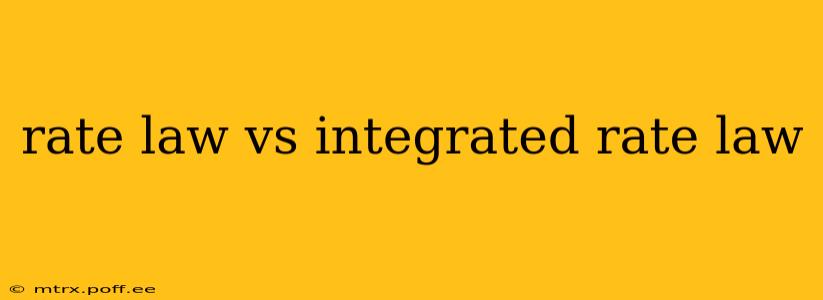Understanding chemical reaction rates is crucial in chemistry, and two key concepts help us achieve this: the rate law and the integrated rate law. While related, they offer different perspectives on reaction kinetics. This article will delve into the differences and applications of each, clarifying common points of confusion.
What is a Rate Law?
The rate law, also known as the differential rate law, expresses the relationship between the reaction rate and the concentrations of reactants. It's an experimentally determined equation that shows how the rate changes as reactant concentrations change. The general form is:
Rate = k[A]m[B]n
Where:
- Rate: The speed at which the reaction proceeds.
- k: The rate constant, a temperature-dependent proportionality constant.
- [A] and [B]: The molar concentrations of reactants A and B.
- m and n: The reaction orders with respect to A and B, respectively. These are not necessarily the stoichiometric coefficients from the balanced chemical equation. They must be determined experimentally.
Example: Consider a reaction 2A + B → C. The rate law might be Rate = k[A][B], indicating a first-order reaction with respect to A and a first-order reaction with respect to B (overall second order). It could also be Rate = k[A]², indicating a second-order reaction with respect to A and a zero-order reaction with respect to B (overall second order). The exponents are determined experimentally, not from the balanced equation.
Determining the Rate Law
The rate law is determined experimentally, typically through initial rate methods or integrated rate law methods. The initial rate method involves measuring the initial rate of the reaction at various starting concentrations of reactants. By comparing the changes in rates with changes in concentrations, the reaction orders (m and n) can be determined.
What is an Integrated Rate Law?
The integrated rate law is derived mathematically from the rate law. It relates the concentration of a reactant to time. Instead of giving the instantaneous rate at a given moment, it provides the concentration of a reactant at any given time during the reaction. The integrated rate law's form depends on the order of the reaction.
Different Orders, Different Integrated Rate Laws:
- Zero-order reactions: [A]t = [A]0 - kt
- First-order reactions: ln[A]t = ln[A]0 - kt or [A]t = [A]0e-kt
- Second-order reactions: 1/[A]t = 1/[A]0 + kt
Where:
- [A]t: Concentration of reactant A at time t.
- [A]0: Initial concentration of reactant A at time t=0.
- k: Rate constant.
- t: Time.
Using Integrated Rate Laws
Integrated rate laws are incredibly useful for:
- Determining the rate constant (k): By plotting the appropriate function of concentration versus time (e.g., [A] vs. t for zero-order, ln[A] vs. t for first-order, 1/[A] vs. t for second-order), you can obtain a straight line with a slope equal to -k (or k, depending on the order).
- Predicting reactant concentrations at various times: By knowing the rate constant and initial concentration, you can calculate the concentration of a reactant at any given time during the reaction.
- Determining reaction half-lives: The half-life (t1/2) is the time it takes for half of the reactant to be consumed. The integrated rate law allows for calculating half-life based on the order of the reaction.
Rate Law vs. Integrated Rate Law: Key Differences Summarized
| Feature | Rate Law | Integrated Rate Law |
|---|---|---|
| Definition | Relates rate to reactant concentrations. | Relates concentration of reactant to time. |
| Equation Form | Rate = k[A]m[B]n | Varies with reaction order (zero, first, second) |
| Application | Determining reaction order; initial rate analysis. | Determining rate constant; predicting concentrations; calculating half-lives. |
| Derivation | Experimental determination. | Derived mathematically from the rate law. |
Frequently Asked Questions
What is the difference between the rate constant and the rate of reaction?
The rate constant (k) is a proportionality constant that reflects the intrinsic reactivity of the reaction at a specific temperature. It's independent of concentration. The rate of reaction is the speed at which the reaction proceeds and is dependent on the concentrations of reactants (as described by the rate law).
How do I determine the order of a reaction?
The reaction order is determined experimentally, usually using the method of initial rates or by analyzing the data using integrated rate laws. Plotting the appropriate function of concentration versus time (as discussed above) helps determine the order of reaction.
Can the rate law be determined from the stoichiometry of the balanced equation?
No. The rate law must be determined experimentally. The stoichiometric coefficients in a balanced chemical equation do not necessarily reflect the reaction orders in the rate law.
Why are integrated rate laws important?
Integrated rate laws are essential for predicting reactant concentrations at specific times, calculating half-lives, and confirming the order of a reaction obtained from initial rate data. They provide a more comprehensive understanding of reaction progression over time.
In conclusion, both rate laws and integrated rate laws are essential tools for understanding and quantifying reaction kinetics. While the rate law provides an instantaneous snapshot of the reaction's speed, the integrated rate law offers a more comprehensive view of how reactant concentrations change over time. Understanding both is fundamental to mastering chemical kinetics.
